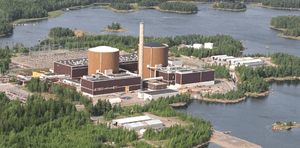VVER
The water-water energetic reactor (WWER),[1] or VVER (from Russian: водо-водяной энергетический реактор; transliterates as vodo-vodyanoi energetichesky reaktor; water-water power reactor) is a series of pressurized water reactor designs originally developed in the Soviet Union, and now Russia, by OKB Gidropress.[2] The idea of a reactor was proposed at the Kurchatov Institute by Savely Moiseevich Feinberg. VVER were originally developed before the 1970s, and have been continually updated. As a result, the name VVER is associated with a wide variety of reactor designs spanning from generation I reactors to modern generation III+ reactor designs. Power output ranges from 70 to 1300 MWe, with designs of up to 1700 MWe in development.[3][4] The first prototype VVER-210 was built at the Novovoronezh Nuclear Power Plant.
| VVER reactor class | |
|---|---|
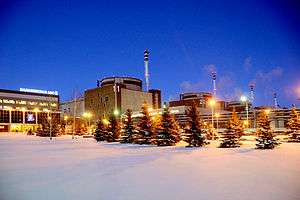 View of the Balakovo Nuclear Power Plant site, with four operational VVER-1000 reactors. Construction of two more units was suspended. | |
| Generation | Generation I reactor Generation II reactor Generation III reactor Generation III+ reactor |
| Reactor concept | Pressurized water reactor |
| Reactor line | VVER (Voda Voda Energo Reactor) |
| Reactor types | VVER-210 VVER-365 VVER-440 VVER-1000 VVER-1200 VVER-TOI |
| Main parameters of the reactor core | |
| Fuel (fissile material) | 235U (LEU) |
| Fuel state | Solid |
| Neutron energy spectrum | Thermal |
| Primary control method | Control rods |
| Primary moderator | Water |
| Primary coolant | Liquid (light water) |
| Reactor usage | |
| Primary use | Generation of electricity |
| Power (thermal) | VVER-210: 760 MWth VVER-365: 1,325 MWth VVER-440: 1,375 MWth VVER-1000: 3,000 MWth VVER-1200: 3,212 MWth VVER-TOI: 3,300 MWth |
| Power (electric) | VVER-210: 210 MWel VVER-365: 365 MWel VVER-440: 440 MWel VVER-1000: 1,000 MWel VVER-1200: 1,200 MWel VVER-TOI: 1,300 MWel |
VVER power stations have been mostly installed in Russia and the former Soviet Union, but also in China, Finland, Germany, Hungary, Slovakia, Bulgaria, India, and Iran. Countries that are planning to introduce VVER reactors include Bangladesh, Egypt, Jordan, and Turkey.
History
The earliest VVERs were built before 1970. The VVER-440 Model V230 was the most common design, delivering 440 MW of electrical power. The V230 employs six primary coolant loops each with a horizontal steam generator. A modified version of VVER-440, Model V213, was a product of the first nuclear safety standards adopted by Soviet designers. This model includes added emergency core cooling and auxiliary feedwater systems as well as upgraded accident localization systems.[5]
The larger VVER-1000 was developed after 1975 and is a four-loop system housed in a containment-type structure with a spray steam suppression system (Emergency Core Cooling System). VVER reactor designs have been elaborated to incorporate automatic control, passive safety and containment systems associated with Western generation III reactors.
The VVER-1200 is the version currently offered for construction, being an evolution of the VVER-1000 with increased power output to about 1200 MWe (gross) and providing additional passive safety features.[6]
In 2012, Rosatom stated that in the future it intended to certify the VVER with the British and U.S. regulatory authorities, though was unlikely to apply for a British licence before 2015.[7][8]
The construction of the first VVER-1300 (VVER-TOI) 1300 MWE unit was started in 2018.[4]
Design
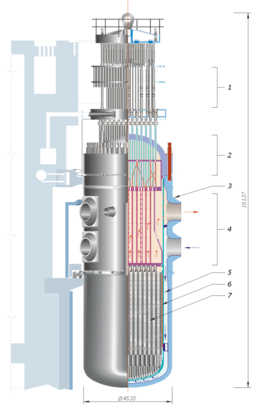
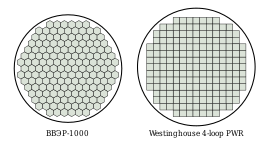
The Russian abbreviation VVER stands for 'water-water energy reactor' (i.e. water-cooled water-moderated energy reactor). The design is a type of pressurised water reactor (PWR). The main distinguishing features of the VVER[3] compared to other PWRs are:
- Horizontal steam generators
- Hexagonal fuel assemblies
- No bottom penetrations in the pressure vessel
- High-capacity pressurizers providing a large reactor coolant inventory

Reactor fuel rods are fully immersed in water kept at 15 MPa pressure so that it does not boil at the normal (220 to over 300 °C) operating temperatures. Water in the reactor serves both as a coolant and a moderator which is an important safety feature. Should coolant circulation fail, the neutron moderation effect of the water diminishes, reducing reaction intensity and compensating for loss of cooling, a condition known as negative void coefficient. Later versions of the reactors are encased in massive steel pressure shells. Fuel is low enriched (ca. 2.4–4.4% 235U) uranium dioxide (UO2) or equivalent pressed into pellets and assembled into fuel rods.
Reactivity is controlled by control rods that can be inserted into the reactor from above. These rods are made from a neutron absorbing material and, depending on depth of insertion, hinder the chain reaction. If there is an emergency, a reactor shutdown can be performed by full insertion of the control rods into the core.
Primary cooling circuits
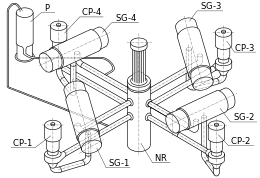
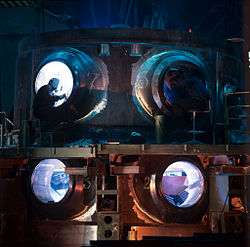
As stated above, the water in the primary circuits is kept under a constant elevated pressure to avoid its boiling. Since the water transfers all the heat from the core and is irradiated, the integrity of this circuit is crucial. Four main components can be distinguished:
- Reactor vessel: water flows through the fuel rod assemblies which are heated by the nuclear chain reaction.
- Volume compensator (pressurizer): to keep the water under constant but controlled pressure, the volume compensator regulates the pressure by controlling the equilibrium between saturated steam and water using electrical heating and relief valves.
- Steam generator: in the steam generator, the heat from the primary coolant water is used to boil the water in the secondary circuit.
- Pump: the pump ensures the proper circulation of the water through the circuit.
To provide for the continued cooling of the reactor core in emergency situations the primary cooling is designed with redundancy.
Secondary circuit and electrical output
The secondary circuit also consists of different subsystems:
- Steam generator: secondary water is boiled taking heat from the primary circuit. Before entering the turbine remaining water is separated from the steam so that the steam is dry.
- Turbine: the expanding steam drives a turbine, which connects to an electrical generator. The turbine is split into high and low pressure sections. To boost efficiency, steam is reheated between these sections. Reactors of the VVER-1000 type deliver 1 GW of electrical power.
- Condenser: the steam is cooled and allowed to condense, shedding waste heat into a cooling circuit.
- Deaerator: removes gases from the coolant.
- Pump: the circulation pumps are each driven by their own small steam turbine.
To increase efficiency of the process, steam from the turbine is taken to reheat coolant before the deaerator and the steam generator. Water in this circuit is not supposed to be radioactive.
Tertiary cooling circuit and district heating
The tertiary cooling circuit is an open circuit diverting water from an outside reservoir such as a lake or river. Evaporative cooling towers, cooling basins or ponds transfer the waste heat from the generation circuit into the environment.
In most VVERs this heat can also be further used for residential and industrial heating. Operational examples of such systems are Bohunice NPP (Slovakia) supplying heat to the towns of Trnava[9] (12 km away), Leopoldov (9.5 km away), and Hlohovec (13 km away), and Temelín NPP (Czech Republic) supplying heat to Týn nad Vltavou 5 km away. Plans are made to supply heat from the Dukovany NPP to Brno (the second-largest city in the Czech Republic), covering two-thirds of its heat needs.[10]
Safety barriers
A typical design feature of nuclear reactors is layered safety barriers preventing escape of radioactive material. VVER reactors have four layers:
- Fuel pellets: radioactive elements are retained within the crystal structure of the fuel pellets.
- Fuel rods: the zircaloy tubes provide a further barrier resistant to heat and high pressure.
- Reactor shell: a massive steel shell encases the whole fuel assembly hermetically.
- Reactor building: a concrete containment building that encases the whole first circuit is strong enough to resist the pressure surge a breach in the first circuit would cause.
Compared to the RBMK reactors – the type involved in the Chernobyl disaster – the VVER uses an inherently safer design. It does not have the graphite-moderated RBMK's risk of a power surge transient or criticality accident. Also the RBMK power stations were constructed without containment structures on grounds of cost as well as the relative ease of re-fueling. (Fuel elements in an RBMK can be replaced while the reactor is running at its nominal output, allowing the continuous operation and plutonium extraction compared to most pressurized water reactors like the VVER which need to be shut down to exchange fuel rod assemblies.)
Versions
VVER-440
One of the earliest versions of the VVER-type, that manifested certain problems with its Containment building-design. As it was at the beginning with the models V-230 and older not constructed to resist the design basis large pipe break, the manufacturer added with the model V-213 a so called Bubble condenser tower, that - with its additional volume and a number of water layers - has the aim to suppress the forces of the rapidly escaping steam without the onset of a containment-leak. As a consequence, all member-countries with plants of design VVER-440 V-230 and older were forced by the politicians of the European Union to shut them down permanently. Bohunice Nuclear Power Plant and Kozloduy Nuclear Power Plant had to close with this two respectively four of their units. Whereas in the case of the Greifswald Nuclear Power Plant, the German regulatory body had already taken the same decision in the wake of the fall of the Berlin wall.
VVER-1000
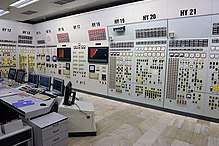
When first built the VVER design was intended to be operational for 35 years. A mid-life major overhaul including a complete replacement of critical parts such as fuel and control rod channels was thought necessary after that.[11] Since RBMK reactors specified a major replacement programme at 35 years designers originally decided this needed to happen in the VVER type as well, although they are of more robust design than the RBMK type. Most of Russia's VVER plants are now reaching and passing the 35 year mark. More recent design studies have allowed for an extension of lifetime up to 50 years with replacement of equipment. New VVERs will be nameplated with the extended lifetime.
In 2010 the oldest VVER-1000, at Novovoronezh, was shut down for modernization to extend its operating life for an additional 20 years; the first to undergo such an operating life extension. The work includes the modernization of management, protection and emergency systems, and improvement of security and radiation safety systems.[12]
In 2018 Rosatom announced it had developed a thermal annealing technique for reactor pressure vessels which ameliorates radiation damage and extends service life by between 15 and 30 years. This had been demonstrated on unit 1 of the Balakovo Nuclear Power Plant.[13]
VVER-1200
The VVER-1200 (or NPP-2006 or AES-2006)[6] is an evolution of the VVER-1000 being offered for domestic and export use.[14][15] The reactor design has been refined to optimize fuel efficiency. Specifications include a $1,200 per kW overnight construction cost, 54 month planned construction time, a 60 year design lifetime at 90% capacity factor, and requiring about 35% fewer operational personnel than the VVER-1000. The VVER-1200 has a gross and net thermal efficiency of 37.5% and 34.8%. The VVER 1200 will produce 1,198 MWe of power.[16][17]
The first two units are being built at Leningrad Nuclear Power Plant II and Novovoronezh Nuclear Power Plant II. More reactors with a VVER-1200/491[18] like the Leningrad-II-design are planned (Kaliningrad and Nizhny Novgorod NPP) and under construction. The type VVER-1200/392M[19] as installed at the Novovoronezh NPP-II has also been selected for the Seversk, Zentral and South-Urals NPP. A standard version was developed as VVER-1200/513 and based on the VVER-TOI (VVER-1300/510) design.
In July 2012 a contract was agreed to build two AES-2006 in Belarus at Ostrovets and for Russia to provide a $10 billion loan to cover the project costs.[20] An AES-2006 is being bid for the Hanhikivi Nuclear Power Plant in Finland.[21]
From 2015 to 2017 Egypt and Russia came to an agreement for the construction of four VVER-1200 units at El Dabaa Nuclear Power Plant.[22]
On 30 November 2017, concrete was poured for the nuclear island basemat for first of two VVER- 1200/523M units at Rooppur in Bangladesh.The Rooppur Nuclear Power Plant will be a 2.4 GWe nuclear power plant in Bangladesh.The two units generating 2.4 GWe are planned to be operational in 2023 and 2024. [23]
On 7 March 2019 China National Nuclear Corporation (CNNC) and Atomstroyexport signed the detailed contract for the construction of four VVER-1200s, two each at the Tianwan Nuclear Power Plant and the Xudabao Nuclear Power Plant. Construction will start in May 2021 and commercial operation of all the units is expected between 2026 and 2028.[24]
From 2020 an 18-month refuelling cycle will be piloted, resulting in an improved capacity utilisation factor compared to the previous 12-month cycle.[25]
Safety features
The nuclear part of the plant is housed in a single building acting as containment and missile shield. Besides the reactor and steam generators this includes an improved refueling machine, and the computerized reactor control systems. Likewise protected in the same building are the emergency systems, including an emergency core cooling system, emergency backup diesel power supply, and backup feed water supply,
A passive heat removal system had been added to the existing active systems in the AES-92 version of the VVER-1000 used for the Kudankulam Nuclear Power Plant in India. This has been retained for the newer VVER-1200 and future designs. The system is based on a cooling system and water tanks built on top of the containment dome.[26] The passive systems handle all safety functions for 24 hours, and core safety for 72 hours.[6]
Other new safety systems include aircraft crash protection, hydrogen recombiners, and a core catcher to contain the molten reactor core in the event of a severe accident.[15][20][27] The core catcher will be deployed in the El Dabaa Nuclear Power Plant build.[28]
VVER-TOI
The VVER-TOI is developed from the VVER-1200. It is aimed at development of typical optimized informative-advanced project of a new generation III+ Power Unit based on VVER technology, which meets a number of target-oriented parameters using modern information and management technologies.[29]
The main improvements from the VVER-1200 are:[4]
- power increased to 1300 MWe gross
- upgraded pressure vessel
- improved core design to improve cooling
- further developments of passive safety systems
- lower construction and operating costs with a 40-month construction time
- use of low-speed turbines
The construction of the first two VVER-TOI units was started in 2018 and 2019 at the Kursk II Nuclear Power Plant.[30][4]
In June 2019 the VVER-TOI was certified as compliant with European requirements for nuclear power plant safety.[4]
An upgraded verison of AES-2006 with TOI standards, the VVER-1200/513, is being built in Akkuyu Nuclear Power Plant in Turkey.[31]
Future versions
A number of designs for future versions of the VVER have been made:[32]
- MIR-1200 (Modernised International Reactor) - designed in conjunction with Czech company ŠKODA JS[33] to satisfy European requirements[34]
- VVER-1500 - VVER-1000 with dimensions increased to produce 1500 MWe gross power output, but design shelved in favour of the evolutionary VVER-1200[35]
- VVER-1700 Supercritical water reactor version.
- VVER-600 two cooling circuit version of the VVER-1200 designed for smaller markets, authorised to be built by 2030 at the Kola Nuclear Power Plant.[36][37]
Power plants
- See the Wikipedia pages for each facility for sources.
Russia recently installed two nuclear reactors in China at the Tianwan Nuclear Power Plant, and an extension consisting of a further two reactors was just approved. This is the first time the two countries have co-operated on a nuclear power project. The reactors are the VVER 1000 type, which Russia has improved incrementally while retaining the basic design. These VVER 1000 reactors are housed in a confinement shell capable of being hit by an aircraft weighing 20 tonnes and suffering no expected damage. Other important safety features include an emergency core cooling system and core confinement system. Russia delivered initial fuel loads for the Tianwan reactors. China planned to begin indigenous fuel fabrication for the Tianwan plant in 2010, using technology transferred from Russian nuclear fuel producer TVEL.[38]
The Tianwan Nuclear Power Plant uses many third party parts. While the reactor and turbo-generators are of Russian design, the control room was designed and built by an international consortium. In this way the plant was brought to meet widely recognised safety standards; safety systems were already mostly in place but the previous monitoring of these systems did not meet international safety standards. The new VVER 1000 plant built in China has 94% of its systems automated, meaning the plant can control itself under most situations. Refueling procedures require little human intervention. Five operators are still needed in the control room.
In May 2010 Russia secured an agreement with the Turkish government to build a power plant with four VVER-1200 reactors at Akkuyu, Turkey.[39][40] However, due to the accident experienced in Fukushima, anti-nuclear environmentalist groups heavily protested the proposed reactor at Akkuyu.
On 11 October 2011 an agreement was signed to build Belarus’ first nuclear power plant at Astravyets, using two VVER-1200/491 (AES-2006) reactors with active and passive safety systems. In July 2016, the reactor vessel for unit 1 has hit the ground during transportation, and though no damage was sustained it was decided to be replaced to allay public fears, delaying the project by a year. Unit 1 is now planned to commence operation in 2019.[41]
In October 2013 the VVER-1000 (AES-92) design was selected by the Jordan Atomic Energy Commission in a competitive tender for Jordan's first twin reactor nuclear power station.[42]
In November 2015 and March 2017 Egypt signed preliminary agreements with Russian nuclear company Rosatom for a first VVER-1200 unit at El Dabaa to start operations in 2024. Discussions continue for final approval.[43][44][45]
2.4 GWe Rooppur Nuclear Power Plant of Bangladesh is under construction.The two units of VVER- 1200/523M generating 2.4 GWe are planned to be operational in 2023 and 2024.[46]
| Power plant | Country | Reactors | Notes |
|---|---|---|---|
| Akkuyu | Turkey | (4 × VVER-1200/513) (AES-2006 with TOI-Standard) | Under construction. |
| Balakovo | Russia | 4 × VVER-1000/320 (2 × VVER-1000/320) | Units 5 and 6 construction suspended. |
| Belene | Bulgaria | (2 × VVER-1000/466B) | Suspended.[47] |
| Belarusian | Belarus | (2 × VVER-1200/491) | Two VVER-1200 units under construction. |
| Bohunice | Slovakia | 2 × VVER-440/230 2 × VVER-440/213 | Split in two plants, V-1 and V-2 with two reactors each. VVER-440/230 units at V-1 plant closed in 2006 and 2008. |
| Bushehr | Iran | 1 × VVER-1000/446 (3 × VVER-1000/528) | A version of the V-320 adapted to the Bushehr site.[48] Unit 2 and 3 planned, unit 4 cancelled. |
| Dukovany | Czech Republic | 4 × VVER 440/213 | Upgraded to 502 MW in 2009-2012. Unit 5 and 6 (VVER 1200) planned to start construction in 2028 |
| Greifswald | Germany | 4 × VVER-440/230 1 × VVER-440/213 (3 × VVER-440/213) | Decommissioned. Unit 6 finished, but never operated. Unit 7 and 8 construction suspended. |
| Kalinin | Russia | 2 × VVER-1000/338 2 × VVER-1000/320 | |
| Hanhikivi | Finland | 1 × VVER-1200/491 | Construction start expected for 2019.[49] |
| Khmelnitskiy | Ukraine | 2 × VVER-1000/320 (2 × VVER-1000/392B) | Units 3 and 4 construction resume planned. |
| Kola | Russia | 2 × VVER-440/230 2 × VVER-440/213 | |
| Koodankulam | India | 2 × VVER-1000/412 (AES-92) (2 × VVER-1000/412) (AES-92) | Unit 1 operational since 13 July 2013; Unit 2 operational since 10 July 2016.[50] Units 3 and 4 under construction. |
| Kozloduy | Bulgaria | 4 × VVER-440/230 2 × VVER-1000 | Older VVER-440/230 units closed 2004-2007. |
| Kursk II | Russia | 1 × VVER-TOI | First VVER-TOI.[30] |
| Leningrad II | Russia | (2 × VVER-1200/491) (AES-2006) | The units are the prototypes of the VVER-1200/491 (AES-2006) and under construction. |
| Loviisa | Finland | 2 × VVER-440/213 | Western control systems, clearly different containment structures. Later modified for a 496 MW output. |
| Metsamor | Armenia | 2 × VVER-440/270 | One reactor was shut down in 1989. |
| Mochovce | Slovakia | 2 × VVER-440/213 (2 × VVER-440/213) | Units 3 and 4 under construction, planned to be operational between 2020 and 2021. |
| Novovoronezh | Russia | 1 x VVER-210 (V-1) 1 x VVER-365 (V-3M) 2 × VVER-440/179 1 × VVER-1000/187 | All units are prototypes. Unit 1 and 2 shutdown. Unit 3 modernised in 2002.[51] |
| Novovoronezh II | Russia | 1 × VVER-1200/392M (AES-2006) (1 × VVER-1200/392M) (AES-2006) | The units are the prototypes of the VVER-1200/392M (AES-2006). Unit 2 is under construction. |
| Paks | Hungary | 4 × VVER-440/213 (2 × VVER-1200/517) | Two VVER-1200 units planned. |
| Rheinsberg | Germany | 1 × VVER-70 (V-2) | Unit Decommisioned. |
| Rivne | Ukraine | 2 × VVER-440/213 2 × VVER-1000/320 (2 × VVER-1000/320) | Units 5 and 6 planning suspended. |
| Rooppur | Bangladesh | 2 × VVER- 1200/523 | Units 1 and 2 under construction |
| Rostov | Russia | 4 × VVER-1000/320 | |
| South Ukraine | Ukraine | 1 × VVER-1000/302 1 × VVER-1000/338 1 × VVER-1000/320 (1 × VVER-1000/320) | Unit 4 construction suspended. |
| Stendal | Germany | (4 × VVER-1000/320) | All 4 units construction cancelled after Germany reunification. |
| Temelin | Czech Republic | 2 × VVER-1000/320 | Both units upgraded to 1080 MWe, units 3 and 4 (VVER 1000) cancelled in 1989 due to change of political regime, now two VVER 1200 are planned. |
| Tianwan | China | 2 × VVER-1000/428 (AES-91) 2 × VVER-1000/428M (AES-91) (2 × VVER-1200) | VVER-1200 construction starts May 2021 and March 2022 |
| Xudabao | China | (2 × VVER-1200) | Construction starts October 2021 |
| Zaporizhzhia | Ukraine | 6 × VVER-1000/320 | Largest nuclear power plant in Europe. |
Technical information
| Specifications | VVER-210[52] | VVER-365 | VVER-440 | VVER-1000 | VVER-1200 (V-392M)[53][54][55] |
VVER-1300[56][57][58] |
|---|---|---|---|---|---|---|
| Thermal output, MW | 760 | 1325 | 1375 | 3000 | 3212 | 3300 |
| Efficiency, net % | 25.5 | 25.7 | 29.7 | 31.7 | 35.7[nb 1] | 37.9 |
| Vapor pressure, in 100 kPa | ||||||
| in front of the turbine | 29.0 | 29.0 | 44.0 | 60.0 | 70.0 | |
| in the first circuit | 100 | 105 | 125 | 160.0 | 165.1 | 165.2 |
| Water temperature, °C: | ||||||
| core coolant inlet | 250 | 250 | 269 | 289 | 298.2[59] | 297.2 |
| core coolant outlet | 269 | 275 | 300 | 319 | 328.6 | 328.8 |
| Equivalent core diameter, m | 2.88 | 2.88 | 2.88 | 3.12 | — | |
| Active core height, m | 2.50 | 2.50 | 2.50 | 3.50 | — | 3.73[60] |
| Outer diameter of fuel rods, mm | 10.2 | 9.1 | 9.1 | 9.1 | 9.1 | 9.1 |
| Number of fuel rods in assembly | 90 | 126 | 126 | 312 | 312 | 313 |
| Number of fuel assemblies[52][61] | 349
(312+ARK (SUZ) 37) |
349
(276+ARK 73) |
349 (276+ARK 73), (312+ARK 37) Kola | 151 (109+SUZ 42),
163 |
163 | 163 |
| Uranium loading, tons | 38 | 40 | 42 | 66 | 76-85.5 | 87.3 |
| Average uranium enrichment, % | 2.0 | 3.0 | 3.5 | 4.26 | 4.69 | |
| Average fuel burnup, MW · day / kg | 13.0 | 27.0 | 28.6 | 48.4 | 55.5 | |
Classification
| Generation | Name | Model | Country | Power plants |
|---|---|---|---|---|
| I | VVER | V-210 (V-1)[63] | Russia | Novovoronezh 1 (decommissioned) |
| V-70 (V-2)[64] | East Germany | Rheinsberg (KKR) (decommissioned) | ||
| V-365 (V-3M) | Russia | Novovoronezh 2 (decommissioned) | ||
| II | VVER-440 | V-179 | Russia | Novovoronezh 3-4 |
| V-230 | Russia | Kola 1-2 | ||
| East Germany | Greifswald 1-4 (decommissioned) | |||
| Bulgaria | Kozloduy 1-4 (decommissioned) | |||
| Slovakia | Bohunice I 1-2 (decommissioned) | |||
| V-213 | Russia | Kola 3-4 | ||
| East Germany | Greifswald 5 (decommissioned) | |||
| Ukraine | Rovno 1-2 | |||
| Hungary | Paks 1-4 | |||
| Czech Republic | Dukovany 1-4 | |||
| Finland | Loviisa 1-2 | |||
| Slovakia | Bohunice II 1-2 Mochovce 1-2 | |||
| V-213+ | Slovakia | Mochovce 3-4 (under construction) | ||
| V-270 | Armenia | Armenian-1 (decommissioned) Armenian-2 | ||
| III | VVER-1000 | V-187 | Russia | Novovoronezh 5 |
| V-302 | Ukraine | South Ukraine 1 | ||
| V-338 | Ukraine | South Ukraine 2 | ||
| Russia | Kalinin 1-2 | |||
| V-320 | Russia | Balakovo 1-4 Kalinin 3-4 Rostov 1-4 | ||
| Ukraine | Rovno 3-4 Zaporozhe 1-6 Khmelnitski 1-2 South Ukraine 3 | |||
| Bulgaria | Kozloduy 5-6 | |||
| Czech Republic | Temelin 1-2 | |||
| V-428 | China | Tianwan 1-2 | ||
| V-428M | China | Tianwan 3-4 | ||
| V-412 | India | Kudankulam 1-2 Kudankulam 3-4 (under construction) | ||
| V-446 | Iran | Bushehr 1 | ||
| III+ | VVER-1000 | V-528 | Iran | Bushehr 2 (under construction) |
| VVER-1200 | V-392M | Russia | Novovoronezh II 1-2 | |
| V-491 | Russia | Baltic 1-2 (construction freezing) Leningrad II 1 Leningrad II 2 (under construction) | ||
| Belarus | Belarus 1-2 (under construction) | |||
| V-509 | Turkey | Akkuyu 1 (under construction) | ||
| V-523 | Bangladesh | Ruppur 1-2 (under construction) | ||
| VVER-1300 | V-510K | Russia | Kursk II 1-2 (under construction) |
Notes
- Other sources - 34,8.
References
- "Kudankulam nuclear plant starts generating power, connected to southern grid". The Times Of India.
- "Historical notes". OKB Gidropress. Retrieved 20 September 2011.
- "WWER-type reactor plants". OKB Gidropress. Retrieved 25 April 2013.
- "Russia's VVER-TOI reactor certified by European utilities". World Nuclear News. 14 June 2019. Retrieved 14 June 2019.
- Prof. H. Böck. "WWER/ VVER (Soviet Designed Pressurized Water Reactors)" (PDF). Vienna University of Technology. Austria Atominstitute. Retrieved 28 September 2011.
- Fil, Nikolay (26–28 July 2011). "Status and perspectives of VVER nuclear power plants" (PDF). OKB Gidropress. IAEA. Retrieved 28 September 2011.
- "Rosatom Intends to Certify VVER in Great Britain and USA". Novostienergetiki.re. 6 June 2012. Retrieved 21 June 2012.
- Svetlana Burmistrova (13 August 2013). "Russia's Rosatom eyes nuclear contracts in Britain". Reuters. Retrieved 14 August 2013.
- "Energy in Slovakia". www.energyinslovakia.sk.
- "Nuclear Power in the Czech Republic - Nuclear Power in Czechia - World Nuclear Association". www.world-nuclear.org.
- Martti Antila, Tuukka Lahtinen. "Recent Core Design and Operating Experience in Loviisa NPP" (PDF). Fortum Nuclear Services Ltd, Espoo, Finland. IAEA. Retrieved 20 September 2011.
- "Modernization works begin at Russia's oldest VVER-1000". Nuclear Engineering International. 30 September 2010. Archived from the original on 13 June 2011. Retrieved 10 October 2010.
- "Rosatom launches annealing technology for VVER-1000 units". World Nuclear News. 27 November 2018. Retrieved 28 November 2018.
- "AES-2006 (VVER-1200)". Rosatom. Archived from the original on 26 August 2011. Retrieved 22 September 2011.
- Asmolov, V. G. (10 September 2009). "Development of the NPP Designs Based on the VVER Technology" (PDF). Rosatom. Retrieved 9 August 2012.
- "Russian nuclear engineers invite foreign suppliers to plant projects". World Nuclear News. 7 December 2015. Retrieved 26 March 2017.
- "Novovoronezh II-2 nears physical start-up". World Nuclear News. 25 March 2019. Retrieved 25 March 2019.
- Status report 108 - VVER-1200 (V-491) (PDF) (Report). Rosatom. 2014. Retrieved 31 December 2016.
- "WWER-1000 reactor plant (V-392)". OKB Gidropress. Retrieved 22 September 2011.
- "$10 billion construction contract signed for two AES 2006 Russian reactors in Belarus". I-Nuclear. 19 July 2012. Retrieved 8 August 2012.
- "Rosatom buys into Fennovoima". World Nuclear News. 28 March 2014. Retrieved 29 March 2014.
- "'Notice to proceed' contracts signed for El Dabaa". World Nuclear News. 11 December 2017. Retrieved 12 December 2017.
- "First Concrete Poured For Unit 1 At Bangladesh's Rooppur". www.nucnet.org. NucNet a.s.b.l Brussels. 30 November 2017. Retrieved 30 November 2017.
- "AtomStroyExport unveils schedule for China projects". World Nuclear News. 3 April 2019. Retrieved 3 April 2019.
- "Russia to transition VVER-1200 to longer fuel cycle". Nuclear Engineering International. 3 March 2020. Retrieved 7 March 2020.
- V.G. Asmolov (26 August 2011). "Passive safety in VVERs". JSC Rosenergoatom. Nuclear Engineering International. Archived from the original on 19 March 2012. Retrieved 6 September 2011.
- "First VVER-1200 reactor enters commercial operation". World Nuclear News. 2 March 2017. Retrieved 3 March 2017.
- "Melt traps ordered for Egyptian nuclear plant". Nuclear Engineering International. 6 February 2018. Retrieved 9 February 2018.
- "Создание типового проекта оптимизированного и информатизированного энергоблока технологии ВВЭР (ВВЭР-ТОИ)". Rosatom Nuclear Energy State Corporation. Archived from the original on 2012-04-25. Retrieved 2011-10-28.
- "AEM Technology sees milestone with first VVER-TOI". World Nuclear News. 17 April 2018. Retrieved 18 April 2018.
- https://www.basedig.com/wikipedia/11vver-power-plants-135150/dataline/4-vver-1200513-aes-2006-with-toi-standard_1/
- "Advanced Nuclear Power Reactors". World Nuclear Association. September 2011. Retrieved 22 September 2011.
- "MIR.1200". ŠKODA JS. Archived from the original on 1 April 2012. Retrieved 23 September 2011.
- "MIR-1200". OKB Gidropress. Retrieved 22 September 2011.
- "WWER-1500 reactor plant". OKB Gidropress. Retrieved 22 September 2011.
- Status report 102 - VVE R-600 (V-498) (VVER-600 (V-498)) (PDF) (Report). IAEA. 22 July 2011. Retrieved 17 September 2016.
- "Russia to build 11 new nuclear reactors by 2030". World Nuclear News. 10 August 2016. Retrieved 17 September 2016.
- "World Nuclear Association - World Nuclear News". www.world-nuclear-news.org.
- "Arrangements Completed for Nuclear Power Plant". Turkish Weekly. 15 August 2011. Archived from the original on 7 April 2014. Retrieved 15 September 2011.
- "Генплан размещения первой турецкой АЭС разработают осенью 2011 года (Master plan of placing the first Turkish nuclear power plant will develop a fall 2011)". Ria Novosti. 22 August 2011. Source for "четырех энергоблоков с реакторами ВВЭР-1200 по российскому" or "four VVER-1200 reactors"
- "Начало эксплуатации первого блока БелАЭС отложили на 2019 год".
- "Jordan selects its nuclear technology". World Nuclear News. 29 October 2013. Retrieved 2 November 2013.
- Ezzidin, Toqa (29 November 2015). "El-Dabaa nuclear station to generate electricity in 2024: Prime Minister". Daily News. Egypt. Retrieved 22 March 2017.
- "Egypt and Russia agree on two contracts for El Dabaa NPP". Nuclear Engineering International. 20 March 2017. Retrieved 22 March 2017.
- Farag, Mohamed (14 March 2017). "Russia launches operations of nuclear unit similar to Dabaa units". Daily News. Egypt. Retrieved 26 March 2017.
- "Rooppur Nuclear Power Plant, Ishwardi". Power Technology.
- "Bulgarian Parliament Votes to Abandon Belene Nuclear Plant". worldnuclearreport.org. 27 Feb 2013. Retrieved 22 Sep 2014. Cite journal requires
|journal=(help) - Anton Khlopkov and Anna Lutkova (21 August 2010). "The Bushehr NPP: Why did it take so long" (PDF). Center for Energy and Security Studies. Retrieved 1 March 2011. Cite journal requires
|journal=(help) - "Impact of Hanhikivi 1 licensing delay remains unclear - World Nuclear News". www.world-nuclear-news.org.
- Kudankulam Nuclear Power Plant attains criticality
- "New life of Novovoronezh 3". Nuclear Engineering International. 3 June 2002. Archived from the original on 14 July 2011. Retrieved 9 March 2011.
- V.V. Semenov (1979). "Основные физико-технические характеристики реакторных установок ВВЭР" (PDF). IAEA.
- "Нововоронежская АЭС-2" (PDF). www.rosenergoatom.ru.
- "Реакторные установки ВВЭР с. 49" (PDF). www.gidropress.ru.
- Андрушечко С.А. и др. (2010). "АЭС с реактором типа ВВЭР-1000".
- Беркович В.Я., Семченков Ю.М. (2012). "Перспективные проекты реакторных установок ВВЭР" (PDF). www.rosenergoatom.ru.
- Долгов А.В. (2014). "Разработка и усовершенствование ядерного топлива для активных зон энергетических установок" (PDF). www.rosenergoatom.ru.
- Якубенко И. А. (2013). "Основные перспективные конфигурации активных зон новых поколений реакторов типа ВВЭР". Издательство Национального исследовательского ядерного университета "МИФИ". p. 52. Retrieved 2018-11-11.
- В.П.Поваров (2016). "Перспективные проекты реакторных установок ВВЭР с. 7" (PDF). www.rosenergoatom.ru.
- Беркович Вадим Яковлевич, Семченков Юрий Михайлович (May 2016). "Развитие технологии ВВЭР – приоритет Росатома" (PDF) (rosenergoatom.ru ed.): 5.
25-27
Cite journal requires|journal=(help) - Сергей ПАНОВ. "У истоков водо-водяных". atomicexpert.com.
- "The VVER today" (PDF). ROSATOM. Retrieved 31 May 2018.
- Сергей Панов. "У истоков водо-водяных". atomicexpert.com.
- Денисов В.П. "Эволюция водо-водяных энергетических реакторов для АЭС p.246".
